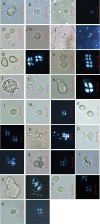Dental calculus evidence of Taï Forest Chimpanzee plant consumption and life history transitions
- PMID: 26481858
- PMCID: PMC4611876
- DOI: 10.1038/srep15161
Dental calculus evidence of Taï Forest Chimpanzee plant consumption and life history transitions
Abstract
Dental calculus (calcified dental plaque) is a source of multiple types of data on life history. Recent research has targeted the plant microremains preserved in this mineralised deposit as a source of dietary and health information for recent and past populations. However, it is unclear to what extent we can interpret behaviour from microremains. Few studies to date have directly compared the microremain record from dental calculus to dietary records, and none with long-term observation dietary records, thus limiting how we can interpret diet, food acquisition and behaviour. Here we present a high-resolution analysis of calculus microremains from wild chimpanzees (Pan troglodytes verus) of Taï National Park, Côte d'Ivoire. We test microremain assemblages against more than two decades of field behavioural observations to establish the ability of calculus to capture the composition of diet. Our results show that some microremain classes accumulate as long-lived dietary markers. Phytolith abundance in calculus can reflect the proportions of plants in the diet, yet this pattern is not true for starches. We also report microremains can record information about other dietary behaviours, such as the age of weaning and learned food processing techniques like nut-cracking.
Figures






References
-
- Boesch C., Marchesi P., Marchesi N., Fruth B. & Joulian F. Is nut cracking in wild chimpanzees a cultural behaviour? J. Hum. Evol. 26, 325–338 (1994).
-
- Boesch C. & Boesch-Achermann H. The Chimpanzees of the Taï Forest: Behavioural Ecology and Evolution. Oxford Univ. Press. Oxford 326 p (2000).
-
- Ross C. Primate life histories. Evol. Anthropol. 6, 54–63 (1998).
-
- Phillips C. & Lancelotti C. Chimpanzee diet: phytolithic analysis of feces. Am. J. Primatol. 76, 757–73 (2014). - PubMed
Publication types
MeSH terms
LinkOut - more resources
Full Text Sources
Other Literature Sources
Molecular Biology Databases
Miscellaneous

